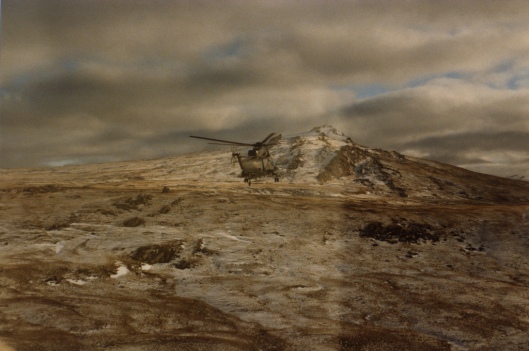
Westland, Mitsubishi, and Agusta manufactured over 400 versions of the H-3 under license. Westland installed a pair of Rolls Royce Gnome H. 1400 turboshafts and a Louis Newmark Mk 31 automatic flight control system in the British Sea Kings. The RN initially ordered fifty-six HAS1 Sea Kings, with 700(S) Squadron receiving the first for test and evaluation in August 1969. Testing resulted in the more powerful HAS2, and the HAS5 with a longer cabin to accommodate the Sea Searcher radar. Westland provided the Egyptian Air Force with a twenty-one-seat Sea King utility transport, minus the external floats, called the “Commando.” The British Royal Marines also ordered this version as the HC4, which conducted extensive combat operations in the Falklands War.
Westland also produced a completely self-contained SAR helicopter that carried a crew of four, nine stretchers, a weather/search radar, smoke and flare dispensers, a flight director system with an auto hover mode, and folding blades for shipboard storage. The RAF made use of this version as the HAR Mk3 and the West German Navy as the Mk 41. Westland exported Sea King variants to India, Norway, Belgium, Pakistan, Australia, and Qatar.
On April 2, 1982, Argentinean forces invaded the Falkland Islands, touching off the Falklands War, or the Guerro Pour Los Malvinas, which lasted until June 20. Both countries possessed many of the same type of helicopters, but, despite the loss of most of their helicopters when an Exocet missile slammed into the container ship Atlantic Conveyor, the British helicopters and crews proved much more effective than the Argentineans. Operating in immoderate weather conditions, the UK machines accomplished extraordinary rescues and inflicted heavy losses on the enemy. When two Wessex HU5s crashed on Fortuna Glacier, another Wessex crew, contending with 90-mph winds and blinding snow, rescued both downed crews. During the short war, Wessex and Sea King helicopters plucked several downed aircrews from the icy waters off the Falklands, in both plane guard and SAR roles. In their baptism of fire, 20 naval Lynxes, armed with Mk 44, Mk 66, or Stingray torpedoes, or four BEA Sea Skua ASMs, scored 100 percent accuracy in the antisurface role. The Lynx HAS 2 was faster and more agile than previous British ASW helicopters and carried an updated Sea Spray search/targeting radar to locate enemy shipping and the 600-mph Sea Skua, designed to attack vessels moving at up to 50 knots. Army Lynxes, and the Chinook saved from the fire-ravaged Atlantic Conveyor, performed more than credible service in transporting troops and supplies throughout the campaign.
Both the British and Argentinean military lost helicopters during the war, in combat and operational accidents. Ground fire shot down British Sea Kings and Argentinean Pumas, and both sides lost helicopters when ships on which they were based sank as a result of naval combat. Argentine Pucara ground attack aircraft shot down a couple of Gazelles, killing the crews, and a friendly fire incident, when HMS Cardiff mistakenly shot down another Gazelle with a Sea Dart, cost the United Kingdom another aircraft and crew. British Sea Harriers shot down at least three Argentinean Pumas and destroyed two others plus an Agusta 109 on the ground. By the end of the conflict British forces had captured nine Bell UH-1H Hueys, two 212s, and several Pumas left on the islands.
During the Falklands War, two Sea Kings ditched into the sea as a result of malfunctions. On both occasions the crew were rescued. However, on May 19th, 1982, a Sea King attempting to land on the ‘Fearless’ crashed into the sea with disastrous consequences. The helicopter was carrying men from the elite Special Air Service. In the accident 22 men were killed, 18 of whom were SAS men. At the time it was believed that a large sea bird, possibly an albatross, had hit the rotor blades casing a major malfunction. However, some have disputed this theory and claimed that it was a major malfunction within the Sea King itself as opposed to any external factor. Regardless of the cause, the speed with which the accident happened meant that few had the time to escape and the SAS had the largest loss of life on a single day since World War Two.
The Sea King was the general workhorse for the military during the Falklands War. With Chinooks being lost when an Exocet hit the ‘Atlantic Conveyor’, the Sea Kings had an even greater importance. Each Sea King was capable of carrying 27 troops a maximum distance of 400 miles. However, on the raid on Pebble Island the SAS men carried so much equipment that each of the three Sea Kings involved carried 19 men.
In 1985, too late for the Falklands War, an Early Airborne Warning version of the Sea King was produced. If this had been available for the Falklands War, then the loss of ships to long range Exocet strikes, such as ‘HMS Sheffield’ may not have occurred. The Sea King’s role is gradually being taken over by the Merlin but the HC Mk 4 is still used by the Royal Marines.